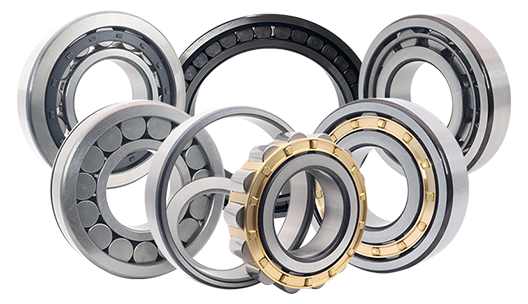Newsroom
Causes and Solutions for Temperature Rise in Cylindrical Roller Bearings
2018-03-25Cylindrical Roller Bearing Structure:
Cylindrical roller bearings typically consist of an inner ring, an outer ring, rolling elements, and a cage. The inner ring fits tightly onto the shaft (known as a shaft washer in thrust bearings), while the outer ring fits more loosely in the housing or bearing bore. The inner and outer rings have raceways along which the rolling elements roll as they rotate. Rolling elements are essential for providing rolling friction, performing "self-rotation," as well as orbiting around the bearing's central axis. The cage keeps the rolling elements evenly spaced. To meet certain application requirements, some cylindrical roller bearings may lack an inner or outer ring or include features like dust shields or seals.

Common Materials:
The materials for rolling elements and inner and outer rings must possess high hardness, contact fatigue strength, good wear resistance, and impact toughness. These components are generally made from chromium alloy steel, with common materials including GCr15, GCr15SiMn, GCr6, and GCr9. After heat treatment, these materials achieve hardness ratings of HRC61-65. The cage is typically stamped from low-carbon steel, though high-speed bearings often use non-ferrous metals (e.g., brass) or plastic cages.
Solutions for Temperature Increase in Cylindrical Roller Bearings
If the temperature of a bearing rises, begin by verifying that no misoperation occurred. If the increase is confirmed, follow these steps:
1. Incorrect Installation Position:
Improper installation can cause excessive axial force on the ends of the rolling elements and the inner and outer ring shoulder, leading to overheating.
2. Select the Specified Precision Grade:
Use the appropriate precision grade bearing for the application.
3. Bent Spindle or Misaligned Housing Bore:
Correct the spindle or housing bore alignment to prevent heat generation.
4. Excessive Belt Tension:
Adjust the belt to an appropriate tension level to prevent heating.
5. Poor Lubrication:
Use the specified lubricant and ensure cleanliness for better performance.
6. Low Assembly Quality:
Improve assembly quality to reduce heat.
7. Creeping Between Inner and Outer Shells:
Replace the bearing and any worn parts, and adjust the impeller balance hole diameter and verify static balance values.
8. Excessive Axial Force:
Clean and adjust the clearance of the sealing ring as necessary.
9. Damaged Bearing:
Replace the bearing if damage is the cause of overheating.
If a bearing exhibits excessive temperature, immediately stop equipment operation, identify the cause, and address the issue following the solutions listed above. As each overheating cause may differ, tailor the response accordingly and seek technical assistance if needed.
Cylindrical roller bearings are widely used as mechanical supports. Their function is to support shafts and associated components while allowing relative rotation or oscillation with the housing, minimizing friction in the joint for high transmission efficiency. Common cylindrical roller bearings adhere to national standards and are manufactured as standardized components by specialized factories. In mechanical design, selecting a suitable bearing type and model based on working conditions and designing a structural assembly is straightforward due to the standardized nature of cylindrical roller bearings and their reliance on rolling friction principles.


